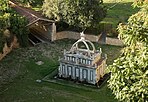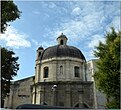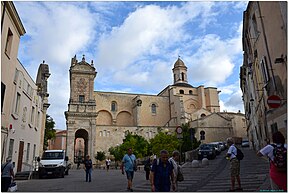Sassari
This article needs additional citations for verification. (March 2024) |
Sassari
| |
|---|---|
| Comune di Sassari | |
From top left: view of the city; Piazza D'Italia; Rosello fountain; Church of Saint Mary of Bethlehem; Piazza Castello; and Cattedrale di San Nicola | |
| Coordinates: 40°43′30″N 8°33′31″E / 40.72500°N 8.55861°E | |
| Country | Italy |
| Region | Sardinia |
| Province | Sassari (SS) |
| Frazioni |
|
| Government | |
| • Mayor | UTC+2 (CEST) |
| Postal code | 07100 |
| Dialing code | 079 |
| Patron saint | Saint Nicholas |
| Saint day | 6 December |
| Website | Official website |
Sassari (.
Since its origins at the turn of the 12th century, Sassari has been ruled by the
As Sardinia's second most populated city, it has a considerable amount of cultural,
Geography
Sassari is located in north-western Sardinia, at 225 metres (738 ft)
Climate
| Climate data for Sassari, Sardinia | |||||||||||||
|---|---|---|---|---|---|---|---|---|---|---|---|---|---|
| Month | Jan | Feb | Mar | Apr | May | Jun | Jul | Aug | Sep | Oct | Nov | Dec | Year |
| Mean daily maximum °C (°F) | 12.2 (54.0) |
12.5 (54.5) |
14.0 (57.2) |
16.3 (61.3) |
20.1 (68.2) |
24.0 (75.2) |
27.7 (81.9) |
27.8 (82.0) |
24.8 (76.6) |
20.7 (69.3) |
16.2 (61.2) |
13.1 (55.6) |
19.1 (66.4) |
| Mean daily minimum °C (°F) | 6.0 (42.8) |
6.1 (43.0) |
7.0 (44.6) |
8.8 (47.8) |
11.9 (53.4) |
15.4 (59.7) |
18.5 (65.3) |
18.9 (66.0) |
16.6 (61.9) |
13.5 (56.3) |
9.8 (49.6) |
7.0 (44.6) |
11.6 (52.9) |
| Average precipitation mm (inches) | 75 (3.0) |
76 (3.0) |
68 (2.7) |
65 (2.6) |
42 (1.7) |
20 (0.8) |
0 (0) |
17 (0.7) |
54 (2.1) |
98 (3.9) |
96 (3.8) |
85 (3.3) |
696 (27.6) |
| Average precipitation days | 7 | 7 | 7 | 6 | 4 | 2 | 0 | 1 | 4 | 6 | 8 | 8 | 60 |
| Mean monthly sunshine hours | 127 | 152 | 186 | 223 | 270 | 310 | 350 | 316 | 257 | 202 | 143 | 115 | 2,651 |
| Source: globopix [9] | |||||||||||||
History
This section needs additional citations for verification. (March 2024) |
Prehistory and ancient history
Although Sassari was founded in the
Middle Ages
The origin of the city remains uncertain. Among the theses, according to folk tradition the first village was founded around the 9th–10th century AD by the inhabitants of the ancient Roman port of Turris Libisonis (current Porto Torres), who sought refuge in the mainland to escape the Saracen attacks from the sea.
It developed from the merger of a number of separate villages, such as San Pietro di Silki, San Giacomo di Taniga, and San Giovanni di Bosove. The oldest mention of the village is in an 1131 document in the archive of the Monastery of St. Peter in Silki where is cited a man named Jordi de Sassaro (George of Sassari), a serf from the nearby village of Bosove. Sassari was sacked by the

In 1284, the Pisans were defeated by the
From 1323, the Republic of Sassari decided to side with the King of Aragon, in whose hands it remained for much of the following centuries, though the population revolted at least three times. The revolts ceased when King
However, in 1420, the city was sold along with the remaining territory for 100,000 florins to the Crown of Aragon, replaced by Spain after 1479 on the joining of the Aragonese and Castilian thrones. During the period of Aragonese and then Spanish domination the city was known as Sàsser in Catalan language and Saçer in old Spanish.[citation needed]
Renaissance
The city alternated years of crisis, featuring economic exploitation, the decrease of the
Modern history


After the end of the Spanish period following the European wars of the early 18th century, the brief period of Austrian rule (1708–1717) was succeeded by domination by the Piedmontese, who then took over the title of Kingdom of Sardinia (1720–1861). In 1795 an anti-feudal uprising broke out in the town, led by the Emissary of the Viceroy Giovanni Maria Angioy, a Sardinian civil servant, who later fought unsuccessfully against the house of Savoy. The city was occupied by troops at the time. The dynasty of the Piedmontese King of Sardinia went on to the monarchs of Italy. Sassari, along with the rest of Italy, became part of the newly created Kingdom of Italy.
At the end of the 18th century the
Sassari became an important industrial center. In the 19th century it was the second most important town in what was to become the future Italy for the production of leather, and in 1848 the Sassarese entrepreneur Giovanni Antonio Sanna gained control of the mine at Montevecchio, becoming the third richest man in the new Kingdom of Italy. The first railway was opened in 1872.
In 1877 the old
At the end of the 19th century new urban developments grew on Cappuccini Hill and to the south of the city, architecturally dominated by Eclecticism, Art Nouveau and Art Deco styles, which created a movement towards the hybrid experimentation of new local architectural styles, known as the Sassarese Liberty.
During the Fascist dictatorship, the town had over fifty thousand inhabitants and new neighbourhoods were built, the most important of these being Monte Rosello and Porcellana, typical examples of
The 8th Stage of the 2023 Giro Donne finished at Salassa on 8 July.
Culture
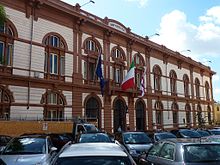
University
The University of Sassari is the oldest in Sardinia (founded by the
The University of Sassari gained first place in 2009 in the ranking for the best “medium-sized” Italian university, awarded by the Censis Research Institute.
Language

Sassarese is spoken in Sassari and its immediate area by approximately 120,000 people out a total population of 175,000 inhabitants; it is also the language of the north-west of Sardinia, including Stintino, Sorso and Porto Torres; in the mid-northern areas of Sardinia, its Castellanesi dialects of Castelsardo, Tergu and Sedini are more similar to the Gallurese.
Main sights

- Archeological site of Monte d'Accoddi: a unique prehistoric monument with a step pyramid construction
- The Pisan City Walls that in the 13th century surrounded the city with 36 towers (at the moment only 6 remain), and the Catalan-Aragonese Castle named Castello di Sassari, demolished in 1877, whose ruins, including some rooms, the basement, and part of a tower were rediscovered in 2008.
- The church of St. Peter in Silki, built in the 12th century but renovated in the 17th century. Here were found the medieval codes known as Condaghe di san Pietro in Silki.
- Corso Vittorio Emanuele is the main street of the medieval town, surrounded by interesting buildings of different ages, such as several examples of Catalan-gothic (as the so-called House of Re Enzo), the baroque church of Sant' Andrea, built by Corsican community, the neoclassic Civic Theatre and Quesada's palace.
- The Cathedral of St. Nicholas of Bari, built in the 13th century and enlarged in Catalan Gothic style from 1480; there is a monument to the Duca di Moriana inside.[10] The façade, belonging to the Baroque Spanish colonial restorations of 1650–1723, has a rectangular portico surmounted by three niches housing statues of saints. The bell tower is in Romanesque style.
- The church and monastery of Santa Maria di Bètlem (13th–19th century). The original façade and parts of monastery are in Lombard Romanesque style, some chapels in International Gothic, while the rest of the building, include the big dome, was rebuilt in Baroque and Neoclassicstyle, by the Sardinian architect Antonio Cano in 1829–34.
- The Church of the Most Blessed Trinity contains a beautiful picture by an unknown artist of the Quattrocento.[10]
- The Cimitero comunale di Sassari (Sassari Cemetery) opened in 1837 adjacent to the Chiesa San Paolo al Cimitero just west of the main railway station
- Palazzo D'Usini, most important example of civilian architecture of the Renaissance period in Sardinia (now housing the main Public Library, therefore open to visits from the public).
- The Fountain of the Rosello, built in 1606 by Genoese craftsmen. It is made by two squared parts surmounted by two crossing arches supporting the statue of St. Gavino.
- University Palace (17th–20th century), originally a Jesuit school.
- The Ducal Palace (current Town Hall, 1775–1806), built for the Duke of the Asinara in the 18th century.
- Piazza d'Italia (19th century) is the main square in Sassari. It is surrounded by interesting buildings such as the Neo-Gothic "Palazzo Giordano" and the neoclassical "Palace of Sassari's Province", where the ancient royal apartments of the House of Savoywere once located.
- Teatro Verdi, opera house and theater for concerts and plays
Museums

- National Archaeological and Ethnographic "G.A. Sanna" Museum
- National Pinacotheca "Mus'A"
- Historical Museum of "Brigata Sassari"
- Museum of Science and Technology (it is constituted by many collections located in several university faculties: agronomiccollection)
- Ethnographic Museum "Francesco Bande"
- Contemporary Art Museum "Masedu"
- Museum and Treasury of the Cathedral
- Museum of History of Sassari
- Museum of Sassari's Diocese
- Museum of Candelieri
- Mario Sironi art collection
- Art gallery "Giuseppe Biasi"
- Pavilion of Sardinian handicraft EXPO "I.S.O.L.A."
Festivals and traditions

- The guilds from the town centre to the church of Santa Maria of Betlem, in commemoration of the end of the plague in 1582, but it probably has older origins, from a cultural tradition from Pisathat as early as in the second half of the 13th century was practiced in some parts of Sardinia.
- The Cavalcata Sarda (the Sardinian Cavalcade), a main event in Sardinia. On the last Sunday of May thousands of people come from all over Sardinia to Sassari to parade through the city in their local folk costumes on foot and ride on hundreds of the best Sardinian horses.
- documentaries in 2009, it has become the most prominent film festivalin Sardinia.
Sport & Infrastructures

Football
The city of Sassari has
Basketball
Sassari has the main basketball team that Dinamo Sassari in the 2014–15 won Italian League, the club won also the Italian Cup in 2014 and 2015 and the Italian Supercup in 2014 and 2019. in 2018–19 the club won the FIBA Europe Cup.
Infrastructures
The city has the main
Government
Administrative subdivision
The Municipality of Sassari was subdivided into ten circoscrizioni (administrative districts), reduced to six since the elections of May 3, 2000, and four since the elections of May 31, 2010.
| Circoscrizioni | Population | Neighborhoods included |
|---|---|---|
| 1° Circoscrizione | 62,981 | Center, Carbonazzi, Porcellana, Rizzeddu, Monserrato, San Giuseppe, Cappuccini, Luna e Sole |
| 2° Circoscrizione | 37,814 | Latte Dolce, Monte Rosello, Santa Maria di Pisa |
| 3° Circoscrizione | 24,969 | Bancali, Caniga, La Landrigga, Li Punti, Ottava, Pian di Sorres, San Giovanni, Sant'Orsola |
| 4° Circoscrizione | 3,258 | Argentiera, Villassunta, Biancareddu, Campanedda, Canaglia, La Corte, La Pedraia, Palmadula, Tottubella, Rumanedda |
Economy
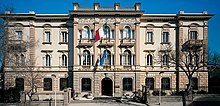
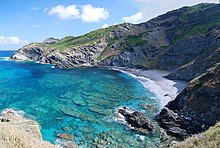
The economy of town is mainly focused on services and the advanced
Several research centers are located in town: the University ones, the Center of Regional Weather Service (Meteo Sar.), the Regional Agency for Environmental Protection (ARPA), the Zooprophylaxis Institute of Sardinia, and many labs of the National Research Center (
Manufacturing includes construction, pharmaceutical, food, typographic industry, and also, indirectly, petrochemical and the new greenchemicals located in Porto Torres.
Tourism is concentrated mainly along the coasts. Platamona, Porto Ferro, Porto Palmas and Argentiera are the principal seaside tourist spots of the municipality.
Transportation
The nearest airport,
Urban and suburban
Dual carriage motorways link Sassari to
.Sport
- A.S.D. Torres Calcio football club, founded in 1903, playing in Serie C
- Torres Calcio Femminile women's football club, playing in Serie B, winners of seven national championships and eight national cups.
- Dinamo Basket Sassari, playing in Lega Basket Serie A
- HC Tangram 1 Sassari women's team handball club, playing in Serie A1
People
Notable people born here include the former presidents of the Italian Republic, Antonio Segni and Francesco Cossiga, and Enrico Berlinguer, secretary of the Italian Communist Party.
Sassari is also the birthplace of Domenico Alberto Azuni, a jurist expert in commercial law.
Personalities
|
Notable historical personages
|
Contemporary personalities
|
International relations
Twin towns – sister cities
Sassari is twinned with:
- Gorizia, Italy, since 1983
- Timișoara, Romania, since 1990
- Gubbio, Italy, since 2002, between the Faradda and the Saint Ubaldo Day
- Viterbo, Italy, since 2006, between the Faradda and the Macchina di Santa Rosa
- Nola, Italy, since 2006, between the Faradda and the Festa dei Gigli
- Palmi, Calabria, Italy since 2006, between the Faradda and the Varia di Palmi
- Dedication of Saint Mary Major
- Campobasso, Italy since 2009, between the Faradda and the Festival dei Misteri
- Barcelona, Spain, since 2010 ("artistic twinning")
See also
- Sassarese language
- Province of Sassari
- University of Sassari
- Sassari Mechanized Brigade
References
- ^ "Superficie di Comuni Province e Regioni italiane al 9 ottobre 2011". Italian National Institute of Statistics. Retrieved 16 March 2019.
- ^ "Statistiche demografiche ISTAT". Retrieved 1 January 2017.
- ^ "Sassari". The American Heritage Dictionary of the English Language (5th ed.). HarperCollins. Retrieved 5 May 2019.
- ^ "Sassari". Merriam-Webster.com Dictionary. Retrieved 5 May 2019.
- ^ "Statistiche demografiche ISTAT". Retrieved 1 January 2017.
- ^ "PIB et principaux composants - volumes". Archived from the original on 2015-09-03. Retrieved 2016-09-26.
- ^ "Neoclassical – Artistic – Itineraries – Sardinia Tourism". Sardegnaturismo.it. Retrieved 2011-09-16.
- ^ a b "Sassari – History and culture". Sardegna.net. Retrieved 2011-09-16.
- ^ "Climate Statistics for Sassari, Sardinia". Retrieved 23 November 2012.
- ^ a b c d e
 One or more of the preceding sentences incorporates text from a publication now in the public domain: Herbermann, Charles, ed. (1913). "Sassari". Catholic Encyclopedia. New York: Robert Appleton Company.
One or more of the preceding sentences incorporates text from a publication now in the public domain: Herbermann, Charles, ed. (1913). "Sassari". Catholic Encyclopedia. New York: Robert Appleton Company.
- ^ "Antonio Cano 1775-1840", paradisola.it, 4 January 2021, accessed 6 January 2023 (in Italian)
- ^ "With him is his cohort Michel Zanche of Logodoro, and their tongues never tire with constant chatter about Sardinia."



